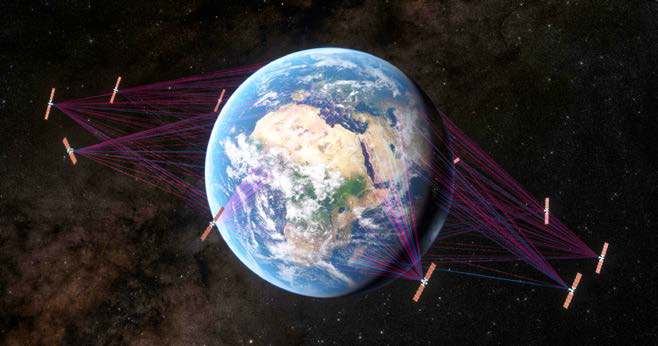How AI/ML is the key to protecting the U.S. Army’s space assets
At the October 2022 Annual Meeting of the Association of the United States Army (AUSA), digital transformation took center stage as U.S. Army leadership and representatives from commercial industry explored the new and innovative software that is delivering immense benefits to America’s largest military branch.

These advancements arrive at a critical moment, as U.S adversaries continue to aggressively develop new technologies that can potentially interfere with and degrade Army warfighting capabilities on the ground, and in the air and space domains as well.
During the modernization and digital transformation sessions at AUSA 2022, attendees learned that the U.S. Army has begun to adopt cutting-edge technologies to be able to maintain both deterrent and warfighting advantages over its adversaries.
Autonomous technologies, such as artificial intelligence (AI) and machine learning (ML), are top of mind for the Army, especially as it pertains to protecting its assets in space.
The U.S. Department of Defense’s (DoD) interests in space do not end with the U.S. Space Force and Air Force.
All military branches have a deep reliance on space, as most of the military connectivity, communications, intelligence, surveillance, and reconnaissance activities likely pass through the DoD’s space architecture at one point in time.
This is particularly true for the Army.
For warfighters in off-grid environments, connectivity provided by satellite communications (SATCOM) can sometimes be their only line of communication to mission leaders and decision- makers at central command.
Army leadership relies on SATCOM to make intel- based decisions and then transmit those orders to the warfighter in theater.
Without SATCOM, warfighters can be left in the dark, putting their mission and lives at risk, and senior decision-makers would lack the real-time intelligence they need to make data-driven decisions.
Army Automation Through AI/ML
U.S. near-peer competitors are fully aware of how critical SATCOM services are to the U.S. Army and look to undermine and degrade them by any means necessary.
From jamming to kinetic attacks — which adversaries such as China and Russia have proven to be capable of employing — the Army must protect its satellites and other space assets from these types of threats by developing and employing new technologies that are capable of defending against such attacks.
Apparently the Army has found that cutting-edge defensive solution in AI/ML. Thankfully, these solutions couldn’t have come at a more opportune time, as U.S. adversaries are now explicitly calling for the attacks of American commercial satellites.

Artistic rendition of SES’ O3b mPOWER constellation.
In recent news coming out of Russia, senior foreign ministry officials at the Kremlin have stated that U.S. commercial satellites and their “quasi-civilian infrastructure may be a legitimate target for a retaliatory strike.”
As the threat to Army assets in space moves from theoretical to looming reality, the DoD has kicked its vision for a resilient space architecture into high- gear, with military leadership looking to AI/ML for automated threat detection and defense of American space assets.
One area of particular interest to the Army is having the ability to switch frequencies and signals across satellites and orbits.
If a satellite were about to be jammed, degraded, or destroyed, the Army can now start to deploy AI/ML software that can detect an attack before such occurs and transfer service over from the soon-to-be compromised satellite to another protected and available asset within the space architecture.
Through advancements in AI/ML automation, detection and response of potential interference or targeting occurs much faster than it would with manually monitoring.
If a space asset has indeed been compromised, AI/ ML enables satellite frequencies to automatically roll over to another satellite in the same orbit, or even a different orbit, denying any enemy attempts to interrupt service.
This new technology is invaluable, as Army decision- makers cannot afford to have congested or degraded communications, especially when critical missions and lives on the ground are at stake.
o3B mPOWER + Smart Tech
For commercial satellite companies like SES Space and Defense, these AI/ML advancements will complement the natively smart capabilities that have been installed on their newer satellites.

The company’s highly anticipated Medium Earth Orbit (MEO) constellation — O3b mPOWER — will be inherently hardened against such adversarial attacks and will have automated detection and response capabilities already baked into the assets.
To take it a step further, SES has also successfully tested O3b mPOWER’s multi-orbit capability set, which is a critical component for AI/ML technology to operate seamlessly.
In September of 2021, SES and Hughes successfully used the Hughes Resource Management System to seamlessly switch signals across SES satellites in MEO and Geostationary orbit (GEO).
According to Jim Hooper, SES Space and Defense’s
Senior Vice President for Space Initiatives, the successfully multi-orbit tests illustrated, “…the power of next-generation satellite services and technologies to provide mission-critical, assured communications to the government and military, at a time when connectivity is increasingly essential.”
Increasingly autonomous COMSATCOM software that leverages AI/ML, combined with the smart technology that has already been built into commercial satellite constellations, such as O3b mPOWER, can provide the U.S. Army with a more resilient space architecture.

As a result, the Army will be fully prepared to thwart adversarial attacks and continue to deliver seamless and interrupted connectivity, communications, intel, and other mission-critical services to warfighters on the ground.

To learn more about how Hughes and SES successfully switched signals between GEO, MEO, and LEO satellites, select this direct infolink...
sessd.com/govsat/
Author David Presgravesis a Staff Writer for GovSat Report, in addition to several other online publications dedicated to defense, military, and federal government agency technologies.


